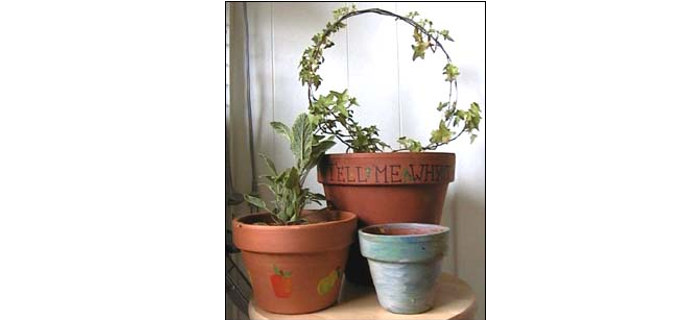Decorating Clay Pots

Transforming ordinary clay pots into works of art is fun and easy. One of these projects will work for any child old enough to hold a paintbrush.
You'll need various size terra-cotta pots to begin with. If you use pots you already have, scrub them well so you've got a clean surface on which to design. Different crafts use different additional materials, but a newspaper or other cover keeps your work surface neat.
Acrylic paint
Turn an ordinary clay pot into an original! Acrylic paint, which comes in a range of colors, works well for semi-permanent crafts like this one. If you wish to really protect the design, you'll have to spray on a clear sealer when the paint is dry. This will also make the pot less porous, which might make it easier to keep plants watered in hot weather.
Young children can brush paint on random patterns. If you'd like, use one color at a time and let them dry in between. As the skill level of the child (or adult) goes up, different effects can be gotten by painting a base color, and then taping off stripes or checks to paint a different color later.
Think of scenes from gardens, portraits of the flowers that will go in the pot, handprints of your child over another color, or arty squiggles. Really, anything works pretty well, especially if you group pleasing colors together. Paint a trio of pots for kitchen herbs. Paint bright, Southwestern-style designs and grow peppers. Anything goes.
Permanent marker designs
Using permanent markers like "Sharpies" is an easier approach, but more minimal in appearance. This craft is probably suited for children who are older or very oriented toward detail work. To make this style work, think of spare artistic traditions. Keith Haring's works might be a good idea source. Look at http://www.haringkids.com/ if that interests you. Also consider the designs found on pottery made by Native Americans. Find inspiration at http://www.umass.edu/arthist/pots/main.html. It's a great site for pictures, grouped by area.
Anything which looks good in black and reddish clay will look good on your pots. Consider having your child write the name of the plant over and over--"basil basil basil." A poem about flowers or gardening, wound around the pot, provides visual and intellectual interest.
Colored glass from the fishbowl to the garden
Remember those lozenge-shaped glass blobs for fishbowls? You can make a safe mosaic with your child. Most sources suggest using broken tiles to make mosaic patterns on pots, but these have rounded edges and won't cut anyone's fingers. They can choke a child, though, so make sure your co-crafter has grown beyond the stage where everything goes in the mouth.
Some home supply stores sell combination mastic and grout for tile projects. You need to talk to the salesperson and tell them that this particular installation will get wet. That way, you'll get the right sticky stuff for your work. Another precaution is to coat the inside of the pot with clear spray acrylic. Moisture won't move through the walls of the pot from the soil if it's pre-sealed.
One you have the right materials, installation is straightforward. Spread the mastic on the pot, then begin placing your colored glass. If your child wants to make a certain design, measure around the pot at the top and bottom, and sketch out a rough flattened shape on some paper. It's easier to move the colors around without permanent fixative in the way. Once the design is pleasing, carefully transfer it piece by piece onto the pot.
The wait for complete drying will probably be the hardest part about this one. Once it's dry, though, with some careful handling, it should last as long as a Roman floor.
These are just jumping-off ideas. As you and your family try them out, you'll make changes that will make them all your own. And remember, a potted plant in an originally-decorated pot makes a gift no one else can give.
Stefani Leto writes and parents in the Bay Area. Mother of an almost-five year old and an infant, she says nothing challenges her mind like parenting. Her work also appears at http://www.windowbox.com and
http://www.folksonline.com/folks/ts/1998/pph.html.
